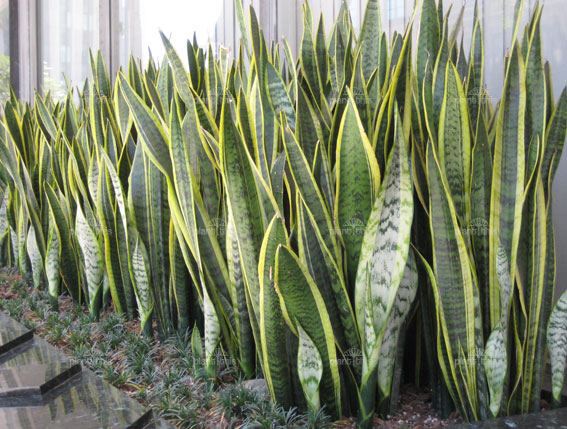 Sansevieria trifasciata, also called snake plant, mother-in-law's tongue or Saint George's sword (in Brazil) is a species of flowering plant in the family Asparagaceae, native to tropical West Africa from Nigeria east to the Congo.
Sansevieria trifasciata, also called snake plant, mother-in-law's tongue or Saint George's sword (in Brazil) is a species of flowering plant in the family Asparagaceae, native to tropical West Africa from Nigeria east to the Congo.It is a common ornamental plant, for a few very good reasons.
Like all easy houseplants, it thrives on neglect. Low light and infrequent, irregular, waterings serve this plant well, which is great for those who want the tropical look, without the bright light and humidity to support it.
 Many people who have grown Sansevieria for years have never seen it flower because they are ‘too good’ to it. A rough repotting (or conversely, letting it get too root bound) is often enough to trick Sansevieria trifasciata into flowering (because if it thinks it might die, making offspring is a good idea), although once flowered, new leaves will not grow from that particular rhizome. While the care is easy and the flowers beautiful, one of its main draws for me originally was its reputation as an “air cleaner”.
Many people who have grown Sansevieria for years have never seen it flower because they are ‘too good’ to it. A rough repotting (or conversely, letting it get too root bound) is often enough to trick Sansevieria trifasciata into flowering (because if it thinks it might die, making offspring is a good idea), although once flowered, new leaves will not grow from that particular rhizome. While the care is easy and the flowers beautiful, one of its main draws for me originally was its reputation as an “air cleaner”.Most people, especially plant people, are familiar with the important role that plants (and other photosynthetic organisms) play in our lives by taking in carbon dioxide from the air and producing oxygen. Air quality is about more than just carbon dioxide and oxygen levels though, but thankfully plants play an important role in helping us with air pollution too.
Sansevieria has many varieties, each of them will give an exotic look to any garden. All of these varieties can be grown the same way.

Growing conditions:
The following is also apllied to closely related species, and basically the whole Sansevieria family.
Light: Grows indoors well, and grows best in places with 2~4 hours of direct sunlight. If your windowsill is bright throughout the day, direct sunlight isn't required.
Leaves turn light yellow, and green becomes grey-green when it is grown under hot, dry sunny condtions so that is not recommended.
Water: Let the soil dry between waterings. During winter, reduce watering to monthly, or whenever the soil is dry to the touch. In the tropics, this plant should be watered every 2 days.
Temperature: They prefer warmth and will suffer if exposed to temperatures below 50ºF.
Soil: A loose, well-drained potting mix. They will do well in a variety of soils, so just make sure if you water, the water drains out of the soil.
Fertilizer: Feed a mild cactus fertilizer during the growing season; do not fertilizer in the winter. If you grow it in a tropical area, it can be fertilized year round, and ordinary nitrogen-rich organic fertilizer can work wonders on the plant.
Propagation:
Sansevieria can be divided easily during repotting. Alternatively, new shoots, which emerge from the soil as spikes, can be taken and potted independently. They are rapid growers once established. Mature leaves can also be used to clone a new plant, which can be done by placing the base of a mature leave on a bowl of water.
After 2 months, the base of the leave should have devolped roots, and after 3 months there should be a little plant poping out of the area where it used to connect with that mother plant.
Grower's Tips:
These are one of the best houseplants for beginners and for striking displays. They are excellent in a grouping and will grow equally do well on the floor or on table-top displays. Native to tropical Africa, the biggest danger is overwatering, and over exposure to strong sunlight. There are many growing varieties, but these are rarely seen in garden centers, depending which country you are on.
-I have 7 years of growing experience on Sansevierias, and I've found alot of things about Sansevierias to be false on the internet.
No comments:
Post a Comment